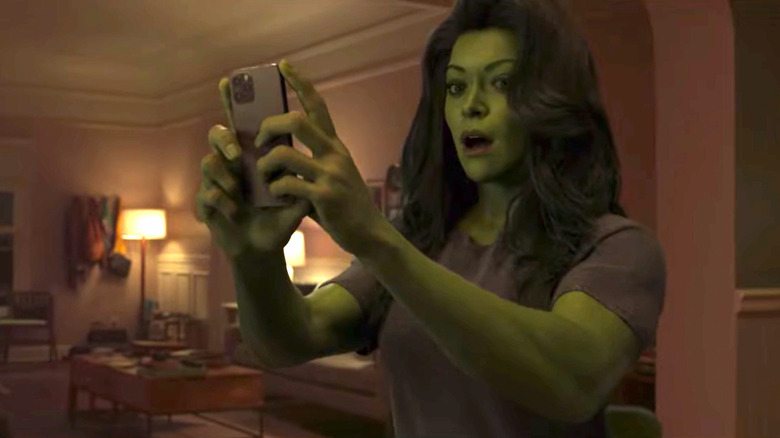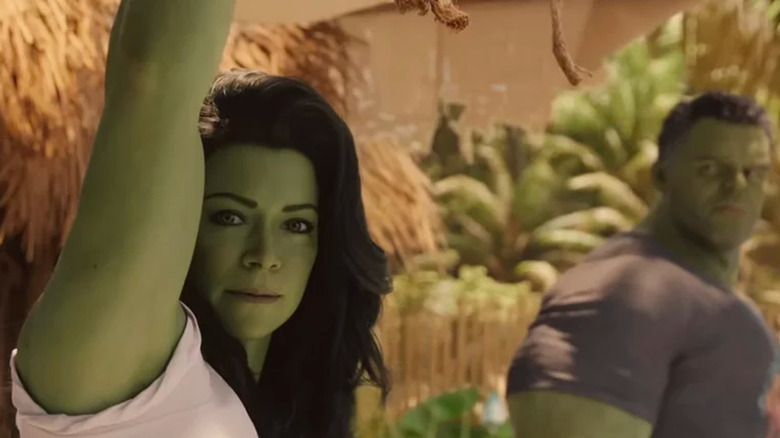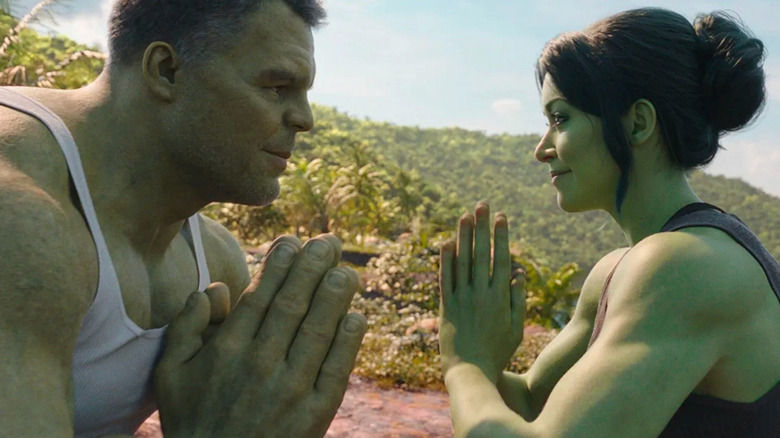She-Hulk's Creators Almost Took The Show's Deadpool-Esque Meta Elements One Step Further
Though "She-Hulk: Attorney at Law" is still creeping towards its official premiere, many of the show's more technical aspects have already been scrutinized within an inch of their lives. The CGI tasked with transforming Tatiana Maslany from a mild-mannered (and human) lawyer into a big, green fighting machine is a topic on many Marvel fans' minds — but so are the fourth wall breaks that will feature heavily throughout the series. Notably, the She-Hulk of the comics often broke the fourth wall herself. But the She-Hulk of the series is already drawing comparisons to Phoebe Waller-Bridge's "Fleabag," as well as to Deadpool, another Marvel hero who's since made the effect his calling card.
Fortunately, the "She-Hulk" creators are already prepared for the criticism. "I like to say that she was doing it long before Deadpool or Fleabag," said Jessica Gao, head writer and executive producer for the series. During a press conference attended by /Film's Valerie Ettenhofer, Gao discussed She-Hulk's history with the fourth wall break at length. In John Byrne's "Sensational She-Hulk," the character was aware that she was, in fact, in a comic book, and would even criticize the writers and editors for a turn of events she didn't particularly agree with. It was an interesting quasi-superpower that would later be retconned in the storylines that followed — but Gao and fellow EP Kat Coiro took major influence from that particular run, and it almost made "She-Hulk" even more meta than it already seems to be.
'Is there another meta element?'
With Deadpool poised to make his MCU debut very soon, not everyone's going to see a precedent for another fourth wall breaker in the universe. But Gao and Coiro put a lot of thought into whether "She-Hulk" would use the effect, and how it could be used in an authentic way. "It went through a lot of evolutionary steps," Gao explained, "a long journey of like, 'How much should she talk to the camera? Is she talking directly to the audience? Is there another meta element? Is she talking to somebody else that's more behind the scenes?'"
At one point, the writers were actually leaning towards the latter:
"There was an iteration in the scripts where, instead of really talking directly to camera, there were kind of text boxes that were editors' notes — like the comic books, how there were editors' notes in comics. And she was actually interacting with the editors' notes that would be on screen."
The creators eventually chose to scale that idea back considerably. For Coiro, building a rapport between the character and the audience took precedence:
"Ultimately it was about finding the balance to where breaking the fourth wall does connect to the audience and draws us in. But not so much so that we're not connecting to her story and the world that we've built ... You've gotten pulled, as the audience, into her inner circle. She's trusting you with all of her internalized thoughts and feelings."
'It's like an extension of her superpower'
She-Hulk won't be breaking the fourth wall to get herself out of sticky situations — or to bully the people writing her story — but series star Tatiana Maslany still sees that awareness as a superpower:
"[S]he's able to go from being Jen to She-Hulk with like a seamlessness. Her consciousness stays the same, and she's aware of the audience ... it's like an extension of her superpower, as she's like, 'I know I'm talking to camera. I know you guys are watching this.' There's something about that super hyperawareness that is like, who she is."
We don't all have to love the fourth wall break, but it's an effect that's here to stay, and the "She-Hulk" creators seem very concerned with wielding it effectively. It will be interesting to see whether their intention does translate to the series, but fans won't have to wait much longer to find out.
"She-Hulk: Attorney at Law" premieres on August 18, 2022 on Disney+.


